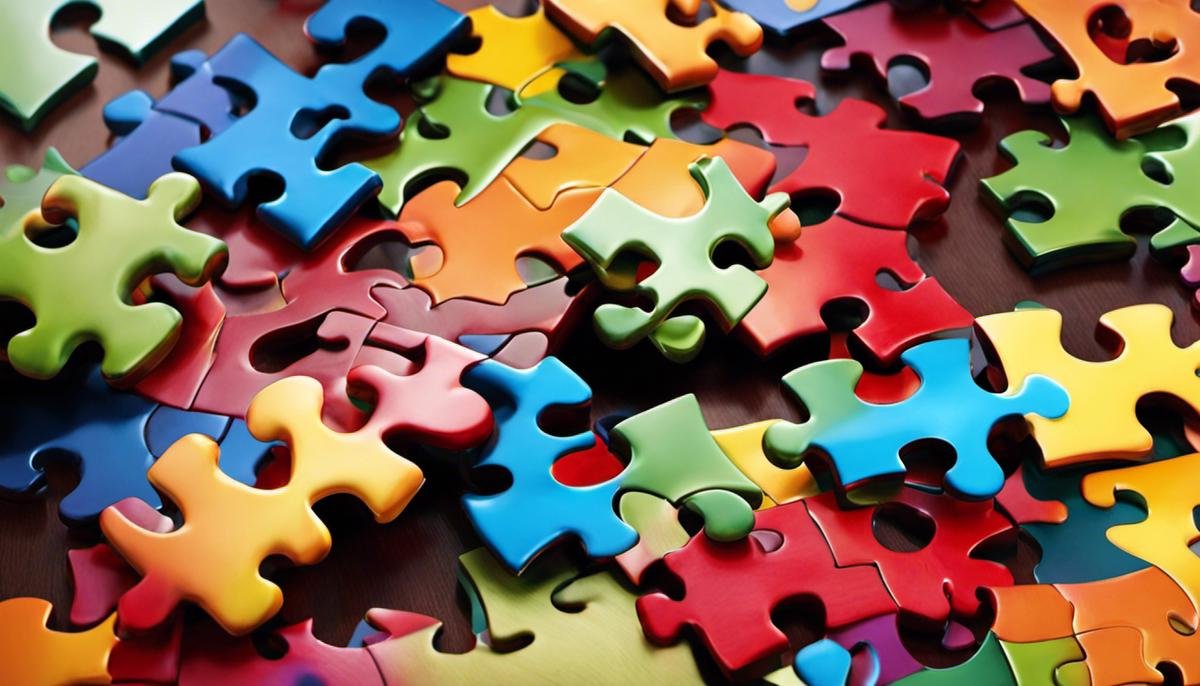
Navigating the multifaceted world of Autism Spectrum Disorder (ASD) often entails questions that delve beyond the symptoms and diagnosis. It involves understanding the individual energy fluctuations that manifest uniquely in each child diagnosed with autism, and how these variations can both challenge and enrich their daily lives. This comprehensive discussion explores not only the nature of autism but also how it intricately intertwines with the child’s energy levels. Along this enriching journey, we’ll offer practical insight and strategies for parents, delve into the scientific perspectives underlying these characteristics, and share personal narratives from families who truly comprehend this dynamic experience.
Understanding Autism
Demystifying the Puzzle of Autism: A Parent’s Perspective
Autism, undeniably, can seem like a confounding puzzle, especially when first encountering it as a parent. Perceptions abound, opinions fly thick and fast and the myriad of information out there can often leave one feeling more bewildered than enlightened. But today, let’s strive to push past the fog of uncertainty and uncover bits of knowledge that can help unravel this enigma called autism.
Understanding Autism
Autism Spectrum Disorder (ASD), as the name suggests, covers a wide range of symptoms and experiences. Mainly a neurodevelopmental disorder, it manifests differently in each child, rendering a one-size-fits-all understanding almost impossible. Yet, some common threads can undoubtedly help in grasping its essence.
Children with autism often exhibit challenges in social interaction and communication, along with restrictive and repetitive behaviors. However, it’s essential to remember this is not due to a lack of intelligence or capability, but rather the unique way in which their brain processes information.
Looking Through Their Lens
One of the most powerful tools to demystify autism is empathy. Strive to see the world from their perspective. For instance, sensory experiences are often intensified for children with autism. The humming of a refrigerator or the buzz from fluorescent lights, which usually fade into background noise for many of us, can be overwhelming for them. Understanding this can build a bridge of commonality and empathy.
Challenging Stereotypes
Most have heard the various stereotypes about individuals with autism – unemotional, socially inept, savants in certain abilities. However, let’s not limit our understanding to these narrow stereotypes. Individuals with autism smile, laugh, cry, show affection, and yes, they crave social interaction and friendship, but they express these feelings and desires in their own unique way.
Honing their Strengths
Children with autism often have unique strengths. What appears as intense obsession with a particular topic or activity could translate into remarkable expertise. By leveraging these strengths, parents can help them excel in the areas they are passionate about.
Seek Support
Never underestimate the power of collective wisdom. Joining support groups can offer insights into dealing with specific challenges and provide emotional succor during difficult times. Sharing experiences and listening to others on the same journey can be incredibly therapeutic.
Into the Future
As daunting as the journey might seem in the early days, a diagnosis of autism isn’t a dead-end. Yes, the road will have its bumps and hurdles. But with tremendous advancements in therapy, education, and society’s increasing acceptance, the outlook is hopeful.
So, instead of struggling with the puzzle of autism, let’s approach it as an adventure — an exploration of the diverse human brain, a journey of growth and understanding, and most significantly, a testament to unconditional love. After all, every child is a beacon of endless possibilities, and children with autism are no exception. So, join hands and let’s march forward, unraveling the world from their eyes, one step at a time!

Energy and Autism: An Intimate Connection
The Underlying Connection: Autism and Energy Levels
Broaching subjects around autism and energy levels can strike a chord for many parents and caregivers. Too often, we overlook this integral aspect of autism, focusing instead on its other facets. So, what is the connection between the two lurking quietly beside our busy lives?
The relationship between autism and energy levels is notably complex and multifaceted, woven intricately into the fabric of each child’s unique behavior and how they perceive their surroundings. They serve as a foundation for daily functioning, much-needed interactions, and individual perceptions. So without further ado, let’s delve into the depths of energy levels and their interaction with autism.
Energy Highs and Lows: It’s More than Just Fatigue
Admit it. The thought of energy levels too often gets linked solely with frequency of physical activities or emotional fatigue. This perspective, although partially accurate, doesn’t provide the full picture. Individuals with autism don’t just get tired in the same way that neurotypical individuals might understand it. Their energy levels fluctuate, depending on many factors such as stimulation from their environment, mental challenges, and the workload of the day ahead.
The effort required to process sensory details might appear straightforward to us, but it can be energy-siphoning for an Autistic child. Just imagine being in a room with a flickering light that you can’t ignore or stop focusing on. This is a reality for many individuals with autism, and it’s in these circumstances that their energy can plummet.
Activity vs. Inactivity: The Yin and Yang
Contrary to common belief, a lot of energy isn’t always equal to constant activity. Children with autism might spend a large part of their day hyper-focused on a single activity, pouring every ounce of their energy into it. Simultaneously, some may swing to the other end of the spectrum, channeling their energy into maintaining a state of inactivity or withdrawing from overstimulating circumstances. Achieving balance here is crucial, and it’s essential we factor in these energy variations when shaping their routines and schedules.
Experience Processing: Personal Fuel Consumption
Every individual with autism processes experiences and sensations uniquely, much like a thumbprint signature with personal capacitor levels. What saps energy from one person might serve as a stimulant for another. As this experience processing varies, so does the energy consumption. Recognizing these triggers and understanding their energy economy will allow us to create a supportive and encouraging environment conducive to their growth.
Unveiling the Connection: Energy And Autism, Hand In Hand
Take a minute and envision autism and energy levels as two dance partners, each moving rhythmically in sync to the music of day-to-day living. Understanding this dance can be a game-changer. It allows us to appreciate that every behavior, every interaction, and every response is an energy exchange. When we adopt this viewpoint and nurture their energy efficiency, we can truly enhance their quality of life.
Much like tending to a plant, managing autism requires love, patience, understanding, and above all, consistent care. And just when we think we’re done, nature surprises us with a beautiful bloom. Understanding the intersection between autism and energy levels is just one more way we can help our kids blossom to their fullest potential.

Impact on Daily Life and Strategies
Energy Flux in Autism: Impacts and Coping Strategies
Managing children’s energy levels is a common theme in parenting, but when a child has autism, this issue can become complex and multifaceted. Autism is a neurological disorder that affects how children perceive and engage with the world. This often leads to fluctuating energy levels that impact their daily routines. Clearing misconceptions, understanding the balance between activity and inactivity, and appreciating the uniqueness of their sensory processing brings both light and tools to address these fluctuations.
One usual misunderstanding is that a child’s energy level is solely related to physical activity or fatigue. However, this is not the case in children with autism where energy levels oscillate due to several factors such as sensory processing or environmental influences. For example, a trip to a crowded place can drain a child’s energy faster due to the overwhelming stimuli. Conversely, engaging in an activity a child enjoys may surge their energy.
Navigating life with autism often involves extended periods of activity and inactivity. There is more to these energy swings than meets the eye. Behind this seemingly unusual pattern, children are expending energy to interpret the world around them, often in unique and fascinating ways.
This brings the spotlight on individualized sensory processing. Children with autism often perceive and process experiences differently, leading to varied energy consumption. Whether it’s heightened sensitivity to certain textures or attention to details that others might overlook, these extraordinary sensory processes directly affect their energy levels.
Understanding and nurturing energy efficiency in children with autism are essential for enhancing their quality of life. So, what strategies can be deployed to manage this?
1. Routine is vital. When children know what to expect, it helps them manage energy usage better. A visual schedule helps present the day’s plan clearly and offers reassurance.
2. Children with autism often have special interests that rev up their energy, so incorporating these into the daily routine is beneficial. If the child loves painting, dedicate certain periods of the day for this activity. This not only lends an energy boost but also nurtures their skills.
3. Mindful breaks are crucial. Periods of downtime and rest allow children to recharge their energy levels. These can include quiet, soothing activities like reading or listening to calming music.
4. Finally, create an autism-friendly environment. This means minimizing potentially overwhelming stimuli and incorporating elements the child finds soothing and comforting.
In conclusion, the way a child with autism experiences and expends energy is deeply interwoven with their unique perception of the world. Being aware and in tune with this concept will allow parents and caregivers to better support these incredible children in managing their energy levels effectively.

Photo by simonshim on Unsplash
Medical Insights: Scientific Perspective on Autism and Energy Levels
How Energy Levels Influence Special Interests in Children With Autism
Promoting a healthy balance of energy in children with autism begins with understanding their unique interests. Special interests can fuel their energies in ways that traditional activities may not, leading to higher engagement and motivation. Scientific studies suggest that when children with autism engage in their preferred activities, their energy levels tend to spike, overall aiding in their attention span, learning, and skill development.
One study published in the Journal of Autism and Developmental Disorders highlighted how intense interests could be used therapeutically to encourage social interaction and learning. For example, incorporating their favorite cartoon characters into language-based tasks can significantly increase their energy and focus, fostering better learning outcomes. This understanding can be a powerful tool for parents and educators, allowing them to create effective, individualized learning strategies that leverage their child’s energy levels.
Role of Routine in Managing Energy Levels
Routines provide predictability, a comfort zone for children with autism. When children know what to expect, their anxiety levels decrease, thereby potentially stabilizing their energy levels. This knowledge can be instrumental in planning a child’s day to optimally utilize their energy levels.
For instance, placing high-energy activities during their peak energy periods and scheduling quieter, more focused tasks during lower-energy periods can help manage fluctuations in energy levels throughout the day. In addition, incorporating routine rest breaks can provide necessary downtime, allowing children to recharge while preventing exhaustion or emotional meltdowns.
Creating an Autism-Friendly Environment
An autism-friendly environment minimizes triggers that may overwhelm and disrupt a child’s energy levels. Excessive noise, bright lights, and high levels of activity may overstimulate children with autism, leading to a rapid depletion of their energy. Modifying the environment to be more autism-friendly – such as dampening harsh lights, maintaining a calm and quiet ambiance, and organizing spaces by clearly defined areas for different activities can help children better manage their energy and avid sensory overload.
Final Thoughts
Every child with autism is wonderfully unique. Hence, it’s crucial to tailor strategies based on individual needs and responses. The interplay between autism and energy levels is a rapidly evolving field, with much potential to enhance our understanding of how to support children with autism better. By understanding these scientific revelations and applying these insights, parents and caregivers can make a meaningful difference in the lives of their children with autism. Now, isn’t that a heartwarming thought to carry forward?

Hearing from Real Families: Stories, Struggles, and Successes
Harnessing the Power of Parental Experience
There’s something distinctly unifying and compassionate about story-sharing, notably when it involves the challenges and triumphs of parenthood. Stories create empathy and make the journey less lonesome. Crucially, when it comes to raising children with autism, sharing real-life experiences of managing fluctuating energy levels can be a profound resource for other parents on a similar path. It provides the comforting affirmation that they’re not alone while offering practical tips that might be implemented in their journey.
Leveraging Shared Experiences
It’s one thing to glean insights from a scientific article; it’s another entirely to hear firsthand how another parent identified their child’s triggers causing energy surges or helped manage frustrations linked with sudden energy drops. Genuine, shared stories presenting the rollercoaster that can be an autistic child’s energy level, ensure parents feel seen, heard, and empowered with gained insights that might suit their child’s needs.
Energy, Emotions and Behavior: The Triple Connection
First-hand tales often reveal the inseparable link between a child’s energy level, emotional state, and their behavior. These personal narratives of battles won and lost serve to delve into the complex interplay, trial-and-error, and eventual understanding that guides substantial adjustments, proving helpful to others navigating similar terrains.
Adopting Tried-and-Tested Routines
Parents have shared the rewards of embracing established routines, noting that these familiar sequences can assist in managing energy levels for kids with autism. Observing how another family’s day is structured might inspire ideas for maintaining consistent routines to help kids feel secure, reducing anxiety and preserving energy for learning and growth.
Harnessing the Power of Special Interests
Valuable tips on managing energy levels also come from parents who recognize and harness their child’s special interests. These interests can not only stimulate positive energy but also provide an avenue to develop social interaction and promote learning. Using real-life examples to illustrate this can inspire others to discover new ways to harness their child’s unique potential.
Promoting Mindful Breaks
There’s fantastic wisdom in the stories of parents who have realized the role of restful periods. As paradoxical as it may seem, these mindful breaks can recharge a child, promoting a better capacity to engage with tasks at their energy peak. Practice and patience are recurring themes; learning to recognize and respect individual limits can result in improved emotional regulation and energy management.
Creating an Autism-Friendly Environment
Creating an autism-friendly environment is another gem often gleaned from shared stories minimizing overwhelming stimuli helps a child with autism process information better, resulting in a calmer and focused state. This approach also aids in avoiding energy drains that lead to fatigue, offering children more opportunities for meaningful engagement.
Remember, community is vital when navigating the labyrinth that is autism. There’s power in storytelling, empathy in shared experiences, and potential in blending personal anecdotes with evidence-based interventions. Supporting each other through shared stories of raising an autistic child has the potential not only to create a tight-knit community but also pave the way for generations of parents who’ll tread this path after us.

Embracing the vibrant energy spectrum of autism gives us the opportunity to truly appreciate the unique lens through which these children view the world. Each anecdote and scientific factoid serves to emphasize that, while their energy levels may seem distinct, it is this apparently challenging trait that often fuels their extraordinary abilities. We hope parents find solace, strength, and strategy in this content, reminding them they are not alone in their journey. The shared experiences of real families and medically backed insights intend to equip, educate, and empower them with an informed perspective that navigates further than symptoms, to understand the vibrant and unique world of their child.




